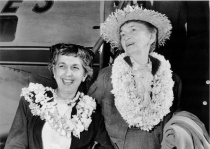Margaret Sanger in Tucson: “Daring to Live”
“When the marvel of the spring came to the desert, you saw the cactus and the flowering, saw the brown floor change to delicate pale yellow, stood in awe of nature daring to live without water. You were reminded of the futility of wearing out your life merely providing food and raiment. Like the challenge of death, which so many of the people there were gallantly facing, the desert itself was a challenge.” – Margaret Sanger on Tucson, in her autobiography

Margaret Sanger in 1959, with friend Grace Sternberg, returning to the United States after a trip to New Delhi, Sanger's final overseas trip.
In 1949, however, Sanger suffered a heart attack, and her son Stuart, a doctor, injected her with Demerol, a recently introduced painkiller not considered addictive at the time. The next year she had a second heart attack, resulting in another long convalescence at the hospital. Her addiction to Demerol intensified; she got Stuart to write prescriptions for her, and would sometimes falsely claim that bottles of the drug had fallen and shattered, which would require further prescriptions to be written. If a nurse refused her demand for Demerol, Sanger would inject it herself. Her son tried to wean her from the drug by collecting empty bottles and filling them with a diluted concentration of the drug, slowly increasing the proportion of water to Demerol until the solution was pure water. This was effective for a while, but eventually Sanger realized she had been duped and endeavored to get her hands back on the drug. She went through other doctors, firing them when they would decrease her dosage, and eventually took to self-administering injections of pure water every 30 minutes. Her addiction, it seemed, was both to the drug itself and the psychological comforts of the injection.
As she continued into old age, Sanger would sometimes walk into the streets at night, clad in her nightgown, occasionally arriving at Stuart’s house, her face bruised from falling down on the asphalt. Stuart experimented with having Sanger stay with him, but eventually found it was better for her to stay in her own house next door. In the summer of 1962, Sanger was declared senile and afflicted with advanced arteriosclerosis. The Superior Court of Pima County appointed Stuart as her legal guardian, and after home care failed she was sent to a nursing home called the House By the Side of the Road. This caused some controversy, as some of Sanger’s friends felt – incorrectly – that her son was stashing her away in a home so he could keep all of her money.
Stuart had sent her bed and some of her rugs to the home so she could enjoy the familiarity of her belongings in her new residence. At the nursing home, Sanger was weaned from Demerol once and for all. She found enjoyment in her daily eggnog (spiked with brandy), her wheelchair rides around the grounds of the home, daily facial massages, and many visitors (including Alan Guttmacher and oral-contraception pioneer John Rock). She was only allowed two visitors each day, and there were many who wished to see her. Because of her senility, however, she did not always recognize her guests.
On September 6, 1966, Sanger died of arteriosclerosis, just shy of her 88th birthday. Her estate of $5 million had dwindled to $100,000. A private service took place at St. Phillips-in-the-Hills, the Episcopal Church Sanger had attended sporadically as a Tucson resident. Rev. George Ferguson eulogized her, and a few family members and local friends were in attendance. The reverend talked about Sanger’s achievements and also reminisced about her joie de vivre, varied interests, and extravagant parties. A more widely attended memorial service was held at St. George’s Church in Stuyvesant Square, New York.





No comments:
Post a Comment